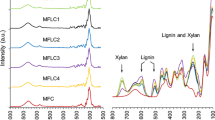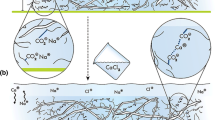Abstract
Microfibrillated cellulose (MFC) obtained by disintegration of bleached softwood sulphite pulp in a homogenizer, was hydrophobically modified by surface silylation with chlorodimethyl isopropylsilane (CDMIPS). The silylated MFC was characterized by Fourier transform infrared spectroscopy (FT-IR), atomic force microscopy (AFM), transmission electron spectroscopy (TEM), X-ray photoelectron spectroscopy (XPS) and white light interferometry (WLI). The degree of surface substitution (DSS) was determined using Si concentrations from XPS survey scans, as well as deconvoluted peaks in high-resolution C1s XPS spectra. The DSS values obtained by the two methods were found to be in good agreement. MFC with DSS between 0.6 and 1 could be dispersed in a non-flocculating manner into non-polar solvents, TEM observations showing that the material had kept its initial morphological integrity. However, when CDMIPS in excess of 5 mol CDMIPS/glucose unit in the MFC was used, partial solubilization of the MFC occurred, resulting in a drop in the observed DSS and a loss of the microfibrillar character of the material. The wetting properties of films cast from suspension of the silylated MFC were also investigated. The contact angles of water on the films increased with increasing DSS of the MFC, approaching the contact angles observed on super hydrophobic surfaces for the MFC with the highest degree of substitution. This is believed to originate from a combination of low surface energy and surface microstructure in the films.
Similar content being viewed by others
Abbreviations
- AFM:
-
atomic force microscopy
- CDMIPS:
-
chlorodimethyl isopropylsilane
- DSS :
-
degree of surface substitution
- FT-IR:
-
fourier transform infrared spectroscopy
- MFC:
-
microfibrillated cellulose
- RGU:
-
repeating glucose unit
- TEM:
-
transmission electron microscopy
- THF:
-
tetrahydrofuran
- WLI:
-
white light interferometry
- XPS:
-
X-ray photoelectron spectroscopy
References
Araki J., Wada M., Kuga S. (2001). Steric stabilization of a cellulose microcrystal suspension by poly(ethylene glycol) grafting. Langmuir 17:21–27
Bonini C., Heux L., Cavaillè J.-Y., Lindner P., Dewhurst C., Terech P. (2002). Rodlike cellulose whiskers coated with surfactant: A small-angle neutron scattering characterization. Langmuir 18:3311–3314
Carlmark A., Malmström E. E. (2003). ATRP grafting from cellulose fibers to create block-copolymer grafts. Biomacromolecules 4:1740–1745
Cash M. J., Chan A. N., Conner H. T., Cowan P. J., Gelman R. A., Lusvardi K. M., Thompson S. A. and Tise F. P.: 1999, US Patent 6 602 994.
Cavaillè J.-Y., Chanzy H., Fleury E. and Sassi J.-F.: 1997, US Patent 6 117 545.
Dorris G. M., Gray, D. G. (1978a). The surface analysis of paper and wood fibers by ESCA (electron microscopy for chemical analysis). I. Application to cellulose and lignin. Cell. Chem. Technol. 12:9–23
Dorris G. M., Gray D. G. (1978b). The surface analysis of paper and wood fibers by ESCA. II. Surface composition of mechanical pulps. Cell. Chem. Technol. 12:721–734
Feng L., Li S. H., Li Y. S., Li H. J., Zhang L. J., Zhai J., Zhu D. B., Song Y. L., Liu B. Q., Jiang L., Zhu D. B. (2002). Super-hydrophobic surfaces: From natural to artificial. Adv. Mater. 14:1857–1860
Goussé C., Chanzy H., Excoffier G., Soubeyrand L., Fleury E. (2002). Stable suspensions of partially silylated cellulose whiskers in organic solvents. Polymer 43:2645–2651
Goussé C., Chanzy H., Cerrada M. L., Fleury E. (2004). Surface silylation of cellulose microfibrils: Preparation and rheological properties. Polymer 45:1569–1575
Grunert M., Winter W. T. (2002). Nanocomposites of cellulose acetate butyrate reinforced with cellulose nanocrystals. J. Polym. Environ. 10:27–30
Herrick F. W., Casebier R. L., Hamilton J. K., Sandberg K. R. (1983). Microfibrillated cellulose: Morphology and accessibility. J. Appl. Polym. Sci., Appl. Polym. Symp. 37:797–813
Heux L., Chauve G., Bonini C. (2000). Nonflocculating and chiral-nematic self-ordering of cellulose microcrystals suspensions in nonpolar solvents. Langmuir 16:8210–8212
Johansson L.-S., Campbell J. M., Koljonen K., Stenius P. (1999). Evaluation of surface lignin on cellulose fibers with XPS. Appl. Surf. Sci. 144–145:92–95
Johansson L.-S., Campbell J., Koljonen K., Kleen M., Buchert J. (2004). On surface distributions in natural cellulosic fibres. Surf. Interface Anal. 36:706–710
Johansson L.-S., Campbell J. M., Fardim P., Hultèn A. H., Boisvert J.-P., Ernstsson M. (2005). An XPS round robin investigation on analysis of wood pulp fibres and filter paper. Surf. Sci. 584:126–132
Kim D.-Y., Nishiyama Y., Shigenori K. (2002). Surface acetylation of bacterial cellulose. Cellulose 9:361–367
Navarro F., Dávalos F., Denes F., Cruz L. E., Young R. A., Ramos J. (2003). Highly hydrophobic sisal chemithermomechanical pulp (CTMP) paper by fluorotrimethylsilane plasma treatment. Cellulose 10:411–424
Sassi J.-F., Chanzy H. (1995). Ultrastructural aspects of the acetylation of cellulose. Cellulose 2:111–127
Turbak A. F., Snyder F. W., Sandberg K. R. (1983). Microfibrillated cellulose, a new cellulose product: Properties, uses, and commercial potential. J. Appl. Polym. Sci., Appl. Polym. Symp. 37:815–827
Zini E., Scandola M., Gatenholm P. (2003). Heterogeneous acetylation of flax fibers: Reaction kinetics and surface properties. Biomacromolecules 4:821–827
Acknowledgments
This research was supported by a grant from the Nanomat research programme of the Norwegian Research Council. Södra Cell, Borregaard, Akzo Nobel and Domsjö Fabriker are also gratefully acknowledged for financial support. Børge Holme at SINTEF Materials and Chemistry is acknowledged for WLI analyses.
Author information
Authors and Affiliations
Corresponding author
Rights and permissions
About this article
Cite this article
Andresen, M., Johansson, LS., Tanem, B. et al. Properties and characterization of hydrophobized microfibrillated cellulose. Cellulose 13, 665–677 (2006). https://doi.org/10.1007/s10570-006-9072-1
Received:
Accepted:
Published:
Issue Date:
DOI: https://doi.org/10.1007/s10570-006-9072-1




